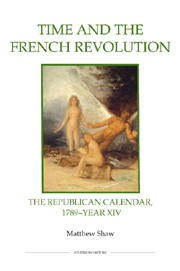Book contents
- Frontmatter
- Contents
- List of illustrations
- Preface
- Miscellaneous Frontmatter
- Acknowledgements
- Abbreviations
- Introduction: writing the history of the republican calendar
- 1 Time and history
- 2 The French republican calendar, 1793–1806: a narrative account
- 3 Cultivating the calendar: the calendar and republican culture in the Year II
- 4 The clash with religion
- 5 Work and rest
- 6 Republican hours
- Conclusion: the legacy of the republican calendar
- APPENDICES
- 1 Timeline of key events, 1788–1806
- 2 The republican calendar: a glossary
- 3 Names of the days of the republican year
- 4 Concordance for the Gregorian and republican calendars
- Bibliography
- Index
2 - The French republican calendar, 1793–1806: a narrative account
Published online by Cambridge University Press: 12 September 2012
- Frontmatter
- Contents
- List of illustrations
- Preface
- Miscellaneous Frontmatter
- Acknowledgements
- Abbreviations
- Introduction: writing the history of the republican calendar
- 1 Time and history
- 2 The French republican calendar, 1793–1806: a narrative account
- 3 Cultivating the calendar: the calendar and republican culture in the Year II
- 4 The clash with religion
- 5 Work and rest
- 6 Republican hours
- Conclusion: the legacy of the republican calendar
- APPENDICES
- 1 Timeline of key events, 1788–1806
- 2 The republican calendar: a glossary
- 3 Names of the days of the republican year
- 4 Concordance for the Gregorian and republican calendars
- Bibliography
- Index
Summary
On 14 July of the fourteenth year of the reign of King Louis XVI (1790), one year after the fall of the Bastille, some 350,000 men, women and children gathered on the Champ de Mars in Paris to celebrate the great fête de la fédération. The rain that fell during the ceremony surely did not detract from the great sense of occasion shared by the huge crowd as Talleyrand, the bishop of Autun, celebrated mass, and the king of the French, Louis XVI, swore his oath of loyalty to the constitution before an altar to the fatherland. The festival, at once both ancient and profoundly new in its symbolism, marked the culmination of a month of events celebrating the ‘federation’ of France and the first anniversary of the Revolution. Although at root a military ceremony in which national guardsmen gathered from across France to swear allegiance to the king and the national assembly, the festival came to symbolise ‘joyous accord’ for the French nation, expressing hope for the future and social and political harmony. The physical space of the Champ de Mars had been reshaped by the people of Paris in the ‘journée of the wheelbarrows’, in which the earth of the old military parade ground was organised into great banks for spectators that would last until the Second Empire.
- Type
- Chapter
- Information
- Time and the French RevolutionThe Republican Calendar, 1789-Year XIV, pp. 29 - 58Publisher: Boydell & BrewerPrint publication year: 2011

